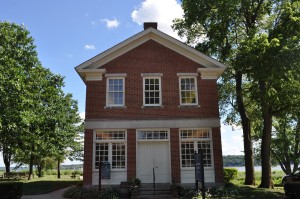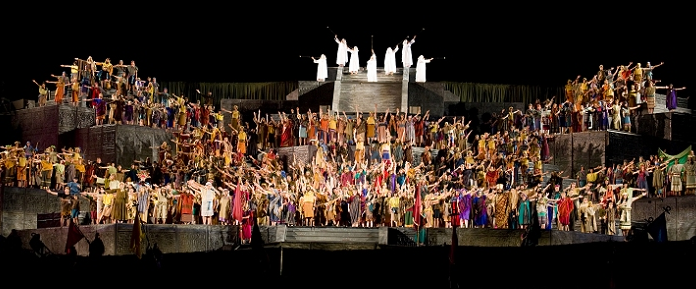The Church of Jesus Christ of Latter-day Saints owns, operates, and maintains a number of Historical Sites, Visitors’ Centers, and Historical Landmarks throughout the United States. The sites represent significant locations in Church history, ranging from Joseph Smith’s birthplace in Vermont to the Mormon Battalion site in San Diego, California.
 It wasn’t until the latter part of the 20th century that The Church of Jesus Christ began to take a more proactive interest in historical sites. Since early Latter-day Saints migrated west, many historical sites, such as homes and businesses in Kirtland, Ohio, and Nauvoo, Illinois, had fallen into disrepair or been demolished completely. When Church leaders began to organize the reconstruction of such sites, there was a lot of research and restorative work to be done. In many cases, property had to be purchased from current owners, as early Latter-day Saints had sold it when they moved west. The Church organized the restoration of many of these historic sites, and erected monuments at other locations, carefully choosing sites where significant events had occurred. Mormon Newsroom reports that “exhibits and guides at each location tell the story of [The Church of Jesus Christ] and its people to thousands of visitors from around the world each year, encouraging a broader understanding of the time, the culture, and the religious significance of each location.”
It wasn’t until the latter part of the 20th century that The Church of Jesus Christ began to take a more proactive interest in historical sites. Since early Latter-day Saints migrated west, many historical sites, such as homes and businesses in Kirtland, Ohio, and Nauvoo, Illinois, had fallen into disrepair or been demolished completely. When Church leaders began to organize the reconstruction of such sites, there was a lot of research and restorative work to be done. In many cases, property had to be purchased from current owners, as early Latter-day Saints had sold it when they moved west. The Church organized the restoration of many of these historic sites, and erected monuments at other locations, carefully choosing sites where significant events had occurred. Mormon Newsroom reports that “exhibits and guides at each location tell the story of [The Church of Jesus Christ] and its people to thousands of visitors from around the world each year, encouraging a broader understanding of the time, the culture, and the religious significance of each location.”
Historical Accuracy
A great deal of research goes into developing an historical site. Don Enders, a recently retired historian for The Church of Jesus Christ, told Mormon Newsroom that before beginning any restoration, extensive research is conducted. He said:
We work with local historians to cover the details in the time period; then we examine the present construction [of the building]. And regardless of condition, the building offers us clues. The type of glass, nails, moldings, construction methods or size of windows that were used, even saw marks in the wood, are all telltale signs of how a building is put together.
Researchers also examine official government records, such as tax and real estate documents to ensure the correct location or building is being restored. Researchers value the historical accuracy of finished projects, and work to ensure that the site is as accurate as possible. Steven L. Olsen, a member of the Church Historic Sites Committee, told Mormon Newsroom:
We try to make the finished product look real, but it’s kind of hybrid between modern and historic technologies. We hope that it’s engaging enough from a historical perspective that people will suspend their disbelief and look past the modern elements of the site to learn about the real history.
Types of Historical Sites
Under the umbrella of the Church History Department and the Historic Sites Committee, there are several types of sites for members and friends of other faiths alike to visit.
- Historic Sites: These include restored buildings and tours in places of historical significance, such as Kirtland, Ohio, and Nauvoo, Illinois.
- Historic Landmarks: These exist primarily to emphasize the Latter-day Saints’ focus on worship, and include historic churches, tabernacles, and temples, such as the St. George Tabernacle in St. George, Utah.
- Historic Markers: These exist in sites where no restoration was possible, but where important pieces of Latter-day Saint history occurred, such as the temple site at Far West, Missouri.
- Visitors’ Centers: There are 10 Visitors’ Centers in the United States, most of them near temples. They are staffed by volunteer missionaries and intend to teach visitors about the doctrines and beliefs of The Church of Jesus Christ.
- Pageants: These outdoor, large-scale plays depict important events from Church history and the Book of Mormon: Another Testament of Jesus Christ. Some of the more well-known include the Hill Cumorah Pageant in Palmyra, NY, and the Mormon Miracle Pageant in Manti, UT.
Mission of Historical Sites
While some of the historic sites are merely signs and landmarks, many sites have full- and part-time volunteer missionaries staffing them. These missionaries are well-equipped to give tours, answer questions, and teach the restored gospel of Jesus Christ. Steven L. Olsen explained: “We preserve site to help provide an experience that opens a person’s heart and soul to the message. Many have found the beginnings of their testimonies when they have gone to the historic sites and had the Spirit bear witness to them”. The purpose of Church historic sites is to provide a window to the past, an opportunity for people to learn more about the history of The Church of Jesus Christ, and an environment for visitors to feel the peace of the gospel of Jesus Christ.
All historic sites are free and open to the public. Find an historical site near you: http://www.mormonnewsroom.org/historic-sites
This article was written by Megan McDaniel


 Watch a video about the restoration of the gospel on lds.org
Watch a video about the restoration of the gospel on lds.org
I would like you to know that the land on which the LDS Historic Sites Foundation and the Topsfield Historical Society worked together in 2005 to create a marker at 22 Boardman Lane recognizing it as the Smith Family homestead for five generations including Joseph Smith’s birthplace, he being the father of the celebrated Joseph Smith, the founder of Mormonism, will soon be offered for sale. Unlike the Samuel Smith marker created and dedicated at the same time which is located on Topsfield town property this one is on private property in a residential area. While the present owner has been gracious in allowing our marker to be located on his land we have no assurance that will still be the case with whoever purchases the lot- which is why I am writing this letter. Would the Foundation be interested in looking into the possibility of purchasing the lot or would you provide our organization with some guidance on how we might jointly ensure the preservation of this historic site and its marker? Thank you for whatever guidance you might provide. Norman J. Isler, President, Topsfield Historical Society
Hello there Norman!
We appreciate you reaching out to us. Unfortunately, HistoryofMormonism.com is a part of a non-profit organization and not affiliated with the official LDS Historic Sites Foundation. If you would like to reach out to them regarding this matter, you can find the site and further contact info here:
http://mormonhistoricsites.org/contact-us/
Thank you!
-Megan